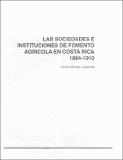| dc.contributor.author | Naranjo Gutiérrez, Carlos | |
| dc.date.accessioned | 2020-11-10T16:58:06Z | |
| dc.date.available | 2020-11-10T16:58:06Z | |
| dc.date.issued | 1998-12 | |
| dc.identifier.issn | 2215-2997 | |
| dc.identifier.other | https://www.revistas.una.ac.cr/index.php/abra/article/view/4308/4150 | |
| dc.identifier.uri | http://hdl.handle.net/11056/18588 | |
| dc.description.abstract | En el curso de las dos últimas décadas
vienen presentándose con frecuencia,
una serie de solventes trabajos realizados por un sinnúmero de investigadores de diversas disciplinas de las ciencias sociales relacionados con la historia agraria.
Desde diferentes enfoques, nos han permitido
aproximarnos más de cerca a la evolución del agro
costarricense. No obstante, a pesar de estos indiscutibles adelantos, continúan existiendo grandes
disparidades entre los temas. Otros problemas,
como por ejemplo la tecnología, el cambio técnico,
las organizaciones sociales y la difusión agrícola,
para citar los más evidentes, han quedado ex
profeso al margen y relegados a una tercera fila.
Entre las lagunas de la historia agraria está
el desconocimiento de las primigenias instituciones de fomento agrícola. De tal manera, creemos
útil o como mínimo interesante reflexionar en torno
a la influencia cultural y técnica desempeñada durante la última década del siglo XIX y primer decenio
del XX por nuestras sociedades de productores. | es_ES |
| dc.description.abstract | Over the last two decades, a number of solid works by a number of researchers from various social science disciplines related to agricultural history have been presented frequently. From different approaches, they have allowed us to get closer to the evolution of Costa Rican agriculture. However, despite these undeniable advances, there are still great disparities between the topics. Other problems, such as technology, technical change, social organizations and agricultural dissemination, to name the most obvious, have been deliberately left out and relegated to a third row. One of the gaps in agrarian history is the lack of knowledge about the original institutions that promoted agriculture. Thus, we believe it is useful or at least interesting to reflect on the cultural and technical influence of our producer societies during the last decade of the 19th century and the first decade of the 20th. | es_ES |
| dc.description.sponsorship | Universidad Nacional, Costa Rica | es_ES |
| dc.language.iso | spa | es_ES |
| dc.publisher | Editorial de la Universidad Nacional | es_ES |
| dc.rights | Acceso abierto | es_ES |
| dc.rights.uri | http://creativecommons.org/licenses/by-nc-sa/4.0/ | * |
| dc.source | Revist ABRA Vol 19, No. 27-28, p. 49-62 | es_ES |
| dc.subject | SOCIEDADES AGRÍCOLAS | es_ES |
| dc.subject | MODERNIZACIÓN | es_ES |
| dc.subject | MODERNIZATION | es_ES |
| dc.subject | INNOVACIONES | es_ES |
| dc.subject | SECTOR AGROPECUARIO | es_ES |
| dc.subject | AGRICULTURAL SECTOR | es_ES |
| dc.subject | COSTA RICA | es_ES |
| dc.subject | AGRICULTURA | es_ES |
| dc.subject | FARMING | es_ES |
| dc.subject | AGRICULTURE | es_ES |
| dc.title | Las sociedades e instituciones de fomento agrícola en Costa Rica 1864-1910 | es_ES |
| dc.title.alternative | Agricultural development societies and institutions in Costa Rica 1864-1910 | es_ES |
| dc.type | http://purl.org/coar/resource_type/c_6501 | es_ES |
| dc.description.procedence | Escuela de Historia | es_ES |


